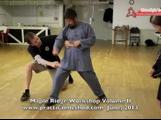“虛領頂勁“ is one of many Tai Chi principles. 虛 means void, which really has misled many people.
Because 虛 is the first word, people believe the neck should be loose and void. I believe the truth is in the word 頂, which can be a noun “on the top”, or a verb “stand up” and “gore.” Based on Wikipedia, “gore” refers to the act of impalement on an animal horn, especially as in bull fighting. I like that. Master Chen talked about this not long ago, using the rubber band to visualize the 頂. We have been working on this ever since. The benefits are obvious. With 頂, you establish a strong center line, create a yin yang split on your upper body (combined with “Qi sink to Dantian” 氣沈丹田), connect your hand with your feet. The end result is that you can direct the opponent’s force to the ground as soon as there’s a contact. Personally, I think this is one of the most fundamental improvements for me.



{ 1 comment… read it below or add one }
我相信“虚领顶劲”之“虚”与脖子无关,而与“领”有关。这里的“领”也不是衣领的领,而是领导的领。
其实衣领的领和领导的领,原本也是一个。衣领之领,虽然围在脖子上,但跟脖子无关,而是指衣服的最上部分,提起它,整件衣服就提起来了。所以领就有了“带领”、“领导”的意思,即英文之“lead”也。
“虚领”的意思是说似乎在百会的上方有绳子将头向上轻轻吊起,是为”领”。说它”虚”,是因为并非实有一根绳子在”领”也。
“虚领”和”顶劲”相对。虚领从上提,顶劲从下顶。都是为了“立身中正”、”中定”,就是陈师讲的中轴不动。
那么光有顶劲不够吗?为什么还要加个虚领呢?这难道不是头上安头,多此一举吗?其实不然。意念中百会上方有一线虚领,脊椎自然会拉开,下颌会微微内收,”含胸拔背”就变得容易了。有人顶劲十足,但下巴总是微翘,这样就很难做到含胸拔背。即使勉强做到,劲路也容易在脖子这儿断成两截。
我想虚领还有一层意思,就是中间这根棍儿虽然不能动,但不能用死劲,要有一点虚的意思。虚才能灵,所以说”满身轻利顶头悬”。“顶头悬”即“虚领顶劲”,虚领顶劲才能满身轻利也。